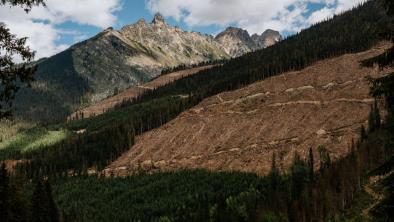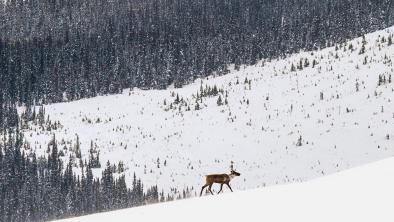Killer whales disappearing off southern B.C.
THe Globe and Mail
Dwindling numbers due to declining birth rates and possible starvation lead scientists to fear orcas are heading toward extinction
VANCOUVER -- There were early signs of starvation and then declining birth rates - now a growing number of adults and calves have vanished from a population of orcas found in the waters of southern British Columbia and northern Washington.
Although no bodies have been found, it's thought that the whales, which rarely stray from the group, have died, perhaps tipping a key population toward extinction.
And scientists say the worst is yet to come for the southern resident orcas and a second, separate population known as the northern residents, which are both heading into winter undernourished because there are so few salmon to feed on.
"It's been a bad summer for both the northern and southern residents. So we expect more mortalities this coming winter," Lance Barrett-Lennard, an adjunct professor at the University of British Columbia and co-chair of a federally appointed orca recovery team, said yesterday.
"We all have our fingers crossed, but I think the research community will be surprised if there are not a large number of mortalities through the winter. ... The key thing from a population-conservation point of view is how many reproductive females make it through the winter. And it's not looking good," he said.
The northern resident population, which ranges around the northern end of Vancouver Island, has relatively stable numbers. The group has about 200 whales, a decline of about 7 per cent since 2000. But reports this summer indicate the population has been struggling to find food.
The southern residents, a population of 83 whales found in Puget Sound and the southern end of the Strait of Georgia, have been hit harder. Not only have they had few salmon to feed on, but the Center for Whale Research, a U.S. facility that has been studying the population for 30 years, reported last week that seven adults - including two reproductive females - have vanished. Two calves are also missing.
Observers had earlier reported signs of starvation in some of the whales, which develop a distinctive condition known as "peanut head" when they lose weight. And the birth rate has declined - with only one calf born this year.
Dr. Barrett-Lennard said the southern resident population fell to 90 in 2004 from a historic level of about 200 and now is at 83.
"In assessing how critical a situation like this is, you have to ask how many reproductive females there are ...[and] are there enough males for breeding purposes? When you take that into account, it drops the population down to less than half. So that makes it a really very small number and ... the fact that this group's recent mortalities include reproductive-age females is worrisome," Dr. Barrett-Lennard said.
He said that with a few more losses of breeding animals, the southern residents could start to slide toward extinction.
"I'm watching a population of killer whales die out in front of my eyes in Alaska. A population that is beyond the point of recovery - down to six animals - so I know it can happen. And I can see that it's quite possible it will happen with the southern residents as well," Dr. Barrett-Lennard said.
He said the AT1 population of transient orcas in Prince William Sound, Alaska, was devastated by the Exxon Valdez oil spill in 1989. At that time the group had 22 whales, but they have not produced any calves since.
Gwen Barlee, policy director for the Wilderness Committee, a B.C.-based environmental group, said resident orcas face a number of problems, but the biggest is a lack of their primary prey, chinook salmon.
"It's a sad story. I'm just hoping this isn't a fatal blow to southern residents," Ms. Barlee said of the recent losses.
"It looks like the whales have been starving to death ... so we need to take immediate steps to protect salmon stocks that they depend on, especially chinook. We also need to be taking steps to protect critical habitat, to protect them from sonar and boat traffic, we need to protect them from toxins that are accumulating in these whales," she said.
"If we value these whales, the federal government will step up to the plate and bloody well do something. ..."
The Wilderness Committee and five other environmental groups launched a lawsuit this month against the federal government, alleging that the Department of Fisheries and Oceans has failed to meet its responsibilities under the Species At Risk Act to protect crucial habitat for northern and southern resident orcas. The case has yet to be heard.
Dan Drais, associate director of Save Our Wild Salmon, a Seattle-based organization, said the crisis shows how badly salmon stocks have been managed all along the West Coast. "It's a sign that we've had a failure of leadership to really take strong action to bring back salmon," he said.
******
Troubled waters for southern orcas
Killer whales off the coasts of British Columbia and Washington State are heading into winter undernourished because of a shortage of salmon. Experts predict their numbers will dwindle.
Residents are killer whales that stay in one geographic area. They generally feed on salmon.
Transients, killer whales which range widely, feed on seals and other mammals.
*****
ALASKA
HEADED FOR EXTINCTION
The transient ATI population in Prince William Sound has gone from 22 in 1989, when the Exxon Valdez oil spill occurred, to six.
Northern residents
Relatively stable population of 200, but that is down 7% since 2000.
SOUTHERN RESIDENT POPULATION
In 1976 the southern populations dropped to 71, during a period when animals were being captured for marine parks...but current numbers still fall short of the historic high of 200 animals.
'80: 83
'84: 74
'96: 97
'01: 78
'04: 90
'08: 86
TONIA COWAN/THE GLOBE AND MAIL
SOURCE: CENTER FOR WHALE RESEARCH


